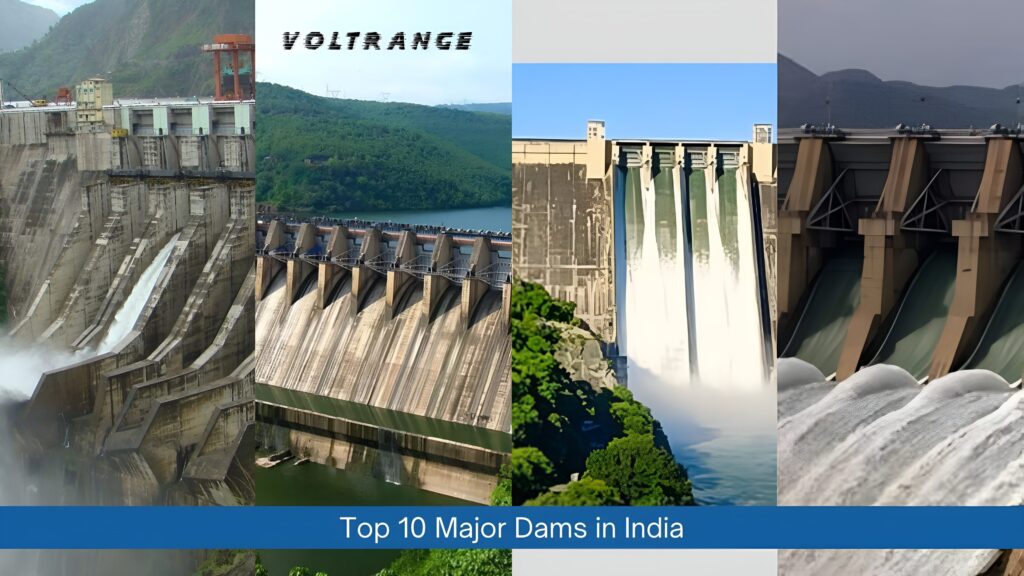
Top 10 Major Dams in India
Major Dams in India: As of 2024, India is home to an impressive 5,334 dams. While some of these are still under construction, they highlight India’s commitment to water conservation and its efforts to harness water not only for basic needs but also for electricity generation. Today, we’ll take a closer look at the top 10 major dams in the country that stand out among the thousands. If you’re curious to find out which dams made the list, keep reading!
1. Tehri Dam
Located in Uttarakhand, Tehri Dam holds the title of the tallest dam in India, standing at a remarkable 260.5 meters. Constructed between 1978 and 2006, this earth and rock-fill embankment dam sits on the Bhagirathi River, a major tributary of the Ganges. Tehri Dam serves multiple purposes, including hydroelectric power generation, irrigation support, and providing water to nearby cities. Its massive reservoir, with a capacity of nearly 3,540 million cubic meters, plays a crucial role in maintaining river flow and ensuring water supply to a large portion of the region. Major Dams in India
2. Chamera Dam
The Chamera I Dam is located in the Chamba district of Himachal Pradesh, near Dalhousie. Built across the River Ravi and completed in 1994, it has a height of 226 meters and a power generation capacity of 540 megawatts. Besides providing electricity, the dam is a key tourist attraction due to Chamera Lake, where visitors can enjoy various water sports on its expansive 3,913 million cubic meter reservoir.
3. Bhakra Dam
The Bhakra Dam, situated on the Satluj River in Himachal Pradesh, is one of India’s most iconic dams. Completed in 1963, this concrete dam stands at 226 meters and creates the vast Gobind Sagar Reservoir, holding around 9.34 billion cubic meters of water. It plays a vital role in supplying irrigation, drinking water, and electricity to several states, including Punjab, Haryana, and Rajasthan. Major Dams in India
4. Lakhwar Dam
Still under construction, Lakhwar Dam is located on the Yamuna River near Lakhwar in Uttarakhand. When completed, this 204-meter dam will help manage water resources for states like Uttarakhand, Uttar Pradesh, and Haryana, providing much-needed water for irrigation and electricity generation with its 58 million cubic meter reservoir. Construction of this project began in 1987, and once finished, it will be a critical resource for water management in the region. Major Dams in India
5. Idukki Arch Dam
One of the tallest arch dams in Asia, Idukki Arch Dam in Kerala stands 168.91 meters tall. This dam, completed in 1975, is a stunning example of engineering, located between the Kuravanmala and Kurathi mountains. The dam forms a large freshwater reservoir, covering 60 square kilometers and supporting a 780-megawatt power station. The Idukki project was aided by Canadian financial support, making it a vital source of electricity for the region.
6. Pakal Dul Dam
Set to be completed soon, Pakal Dul Dam is located in Kishtwar, Jammu & Kashmir. It will be 167 meters tall and produce 1,000 megawatts of electricity once operational. Built on the Marusudar River, a tributary of the Chenab River, the dam will significantly boost power generation in the region. It includes a 10-kilometer tunnel designed to transport water to a nearby power station, with a reservoir capacity of 108 million cubic meters.
7. Sardar Sarovar Dam
The Sardar Sarovar Dam, located on the Narmada River in Gujarat, is a key component of a multi-state project aimed at improving irrigation and electricity production. The dam, which measures 1,210 meters long and 163 meters high, was completed in 2017. It boasts a reservoir with a capacity of 0.95 million hectare meters, which provides water and electricity to Gujarat, Madhya Pradesh, Maharashtra, and Rajasthan. Major Dams in India
8. Ranjit Sagar Dam
Also known as Thein Dam, Ranjit Sagar Dam is located on the Ravi River, straddling the borders of Punjab and Jammu & Kashmir. Completed in 2001 after work began in 1981, the dam stands 160 meters tall and 617 meters long. Its large freshwater reservoir holds 1.25 billion cubic meters of water and generates 600 megawatts of electricity, making it a key player in the region’s water and power supply.
9. Srisailam Dam
The Srisailam Dam is situated on the Krishna River between Andhra Pradesh and Telangana. Standing 145 meters tall and stretching 512 meters long, this dam was completed in 1981. It serves as both a water resource for agriculture and a powerhouse, capable of generating 1,670 megawatts of electricity. With a reservoir of 178.74 TMC (Thousand Million Cubic Feet), Srisailam Dam is one of the largest hydroelectric projects in the country.
10. Baglihar Dam
Located on the Chenab River in Jammu and Kashmir, Baglihar Dam stands 143 meters tall and can store up to 475 million cubic meters of water. Completed in two phases, with the final stage finished in 2016, this dam is designed to boost electricity generation with a capacity of 450 megawatts per phase. The dam also sparked international discussions with Pakistan over water treaty concerns. Major Dams in India
Conclusion
These are some of the largest and most significant dams in India as of 2024. While a few are still under construction, they are set to become key contributors to the nation’s water and power management. With more projects in the pipeline, India’s dam infrastructure will only continue to grow, potentially breaking more records in the near future. Keep an eye on future developments—you never know when India might build its next tallest or largest dam! Major Dams in India





More Stories
which of the following statements is true about education and lifetime earnings? Complete Guide Here
Statekaidz.com: Education with Fun For Kids 2025
Top 5 Richest States in India by GDP